#rosalie zdzienicka fanshel
Explore tagged Tumblr posts
Text

losing my entire mind at this paragraph from Beyond blood brothers: queer Bruce Springsteen by Rosalie Zdzienicka Fanshel. im so emotional
[Image text: At 6'4" and of sturdy build, he towers over Bruce and the other members of E Sreet, who are all several inches shorter (Springsteen is 5' 8"). Clemons was also older than the rest of the band, and it is no small matter that he was African American in a group that is otherwise mostly Jewish and Italian American. Wielding his powerful (and phallic) saxophone, the Big Man is the only one who ever gets to be a bit more 'boss' than the Boss. Throughout his performances Springsteen supplicates himself to Clemons: he variously leans into him for comfort, prances around him like a puppy in love, and elevates him with introductory titles such as 'King of the World' and 'Master of the Universe', whose name should not even need to be pronounced. Bruce worships Clarence and invites the audience to do the same. Photographs from concerts throughout the early 1970s show the same unabashed gaze of adoration that was so carefully constructed on the cover of Born to Run. /end ID.]
92 notes
·
View notes
Text
she (FANSHEL, ROSALIE ZDZIENICKA. “Beyond Blood Brothers: Queer Bruce Springsteen.” Popular Music, vol. 32, no. 3, 2013, pp. 359–83. JSTOR, http://www.jstor.org/stable/24736780) is like a brother to me.
#one of the fave's !!!#also the best part is#is that another one of the faves (oh boy! masculinities in music) is one of the first references#bruce springsteen#squish speaks
0 notes
Text



Vote for Bruce and Clarence if you haven't already
From "Beyond blood brothers: queer Bruce Springsteen" by Rosalie Zdzienicka Fanshel
Old Man Yaoi Semifinals

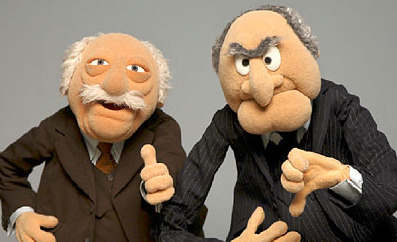
17K notes
·
View notes
Text
excerpts from “Beyond blood brothers: queer Bruce Springsteen” by Rosalie Zdzienicka Fanshel
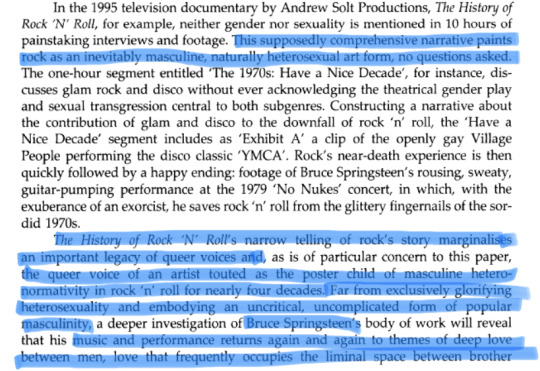

This supposedly comprehensive narrative paints rock as an inevitably masculine, naturally heterosexual art form, no questions asked.
The History of Rock ‘N’ Roll’s narrow telling of rock’s story marginalises an important legacy of queer voices and...the queer voice of an artist touted as the poster child of masculine heterosexuality in rock ‘n’ roll for nearly four decades. Far from exclusively glorifying heterosexuality and embodying an uncritical, uncomplicated form of popular masculinity...Bruce Springsteen’s...music and performance returns again and again to themes of deep love between men, love that frequently occupies the liminal space between brother and lover, a romantic ‘darkness on the edge of town.’
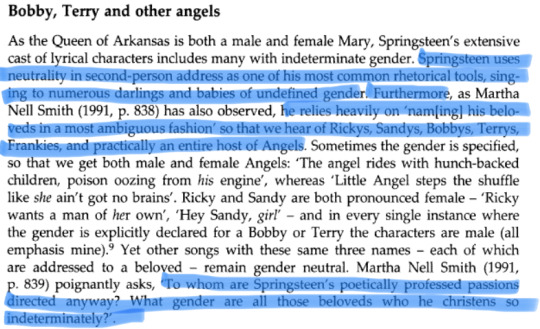
Springsteen uses neutrality in second-person address as one of his most common rhetorical tools, singing to numerous darlings and babies of undefined gender. Furthermore...he relies heavily on ‘nam[ing] his beloveds in a most ambiguous fashion’ so that we hear of Rickys, Sandys, Bobbys, Terrys, Frankies, and practically an entire host of Angels.
‘To whom are Springsteen’s poetically professed passions directed anyway? What gender are all those beloveds who he christens so indeterminately?’


The ‘Backstreets’ lyrics are strictly gender neutral. Beyond the scope of pronouns, however, I argue in favor of reading the song as the story of betrayal between male lovers based on the overall content of the lyrics. Springsteen takes up iconic ‘masculine’ themes in this song that he explores in many others.
It is the overtly male landscape of ‘Backstreets’ that leads many to interpret the narrator and Terry as two male friends. But just what is the nature of this friendship? What makes their lives together so forbidden that they must hide on the backstreets? Lines like ‘Sleeping in that old abandoned beach house’ and ‘With a love so hard and filled with defeat’ suggest a romantic liminality in the characters’ relationship. The language is quite emotionally charged for a strictly platonic friendship.
Regardless of any particular listener’s own gendering of ‘Backstreet’s’ Terry, the fact that Springsteen himself has refused to definitively say one way or the other is in itself a queering of the character.
Springsteen...essentially links a photo of himself gazing lovingly at his male friend with the romantic feeling of such lyrics as ‘Laying here in the dark you are like an angel on my chest / Just another tramp of hearts crying tears of faithlessness.’


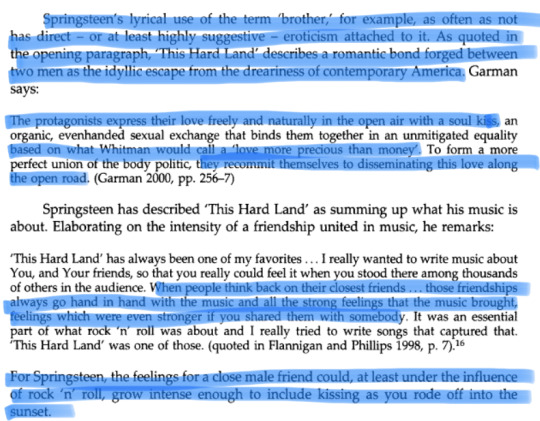
Among Springsteen’s new influences was Walt Whitman...Springsteen mirrored the significance of homosociality and homoeroticism inherent in Whitman’s vision. Whitman spoke extensively in terms both spiritual and sexual about his feelings for his fellow ‘brothers,’ which he distilled into the concept of ‘adhesive love.’
Throughout the epic poetry collection Leaves of Grass, written between the 1850s and 1890s, Whitman interweaves his views of the United States with his love for its men. Many Springsteen songs read like Whitmanian portraits of the American moral landscape, not a few sharing Whitman’s erotic language to describe his feelings for his brothers.
Springsteen’s lyrical use of the term ‘brother,’ for example, as often as not has direct - or at least highly suggestive - eroticism attached to it. ... ‘This Hard Land’ describes a romantic bond forget between two men as the idyllic escape from the dreariness of contemporary America.
The protagonists express their love freely and naturally in the open air with a soul kiss...based on what Whitman would call ‘a love more precious than money.’ ...they recommit themselves to disseminating this love along the open road.
When people think back on their closest friends...those friendships always go hand in hand with the music and all the strong feelings that the music brought, feelings which were even stronger if you shared them with somebody.
For Springsteen, the feelings for a close male friend could, at least under the influence of rock ‘n’ roll, grow intense enough to include kissing as you rode off into the sunset.


...the performances that culminate in Bruce and Clarence’s passionate kiss are those of songs about the fantasy of escaping together... Springsteen’s slide across the stage to meet Clemons’s waiting lips is a climactic corporeal embodiment of the lyrics he sings. But with the subversion of gender from the abstract woman of the storyline to Clemons’s very real person, is Springsteen not so subtly indicating just whose ‘velvet rims’ he wants to wrap his legs around, who he really wants to climb into his car as he ‘pulls out of here to win?’
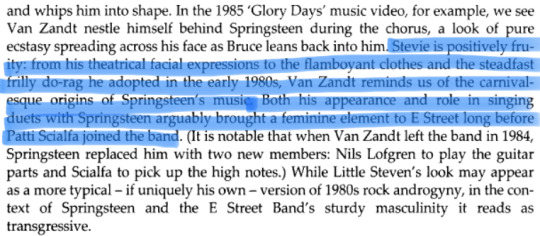
Stevie is positively fruity: from his theatrical facial expressions to the flamboyant clothes and the steadfast frilly do-rag he adopted in the early 1980s, Van Zandt reminds us of the carnivalesque origins of Springsteen’s music. Both his appearance and role in singing duets with Springsteen arguably brought a feminine element to E Street long before Patti Scialfa joined the band.
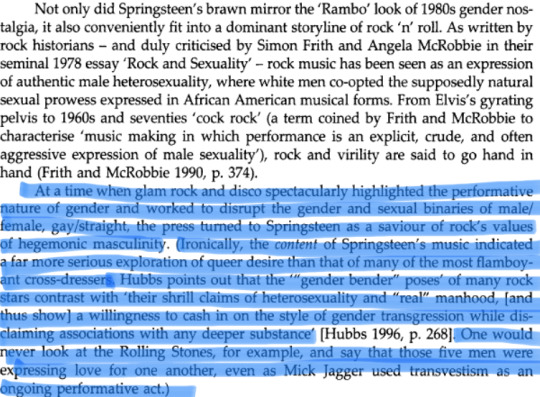
At a time when glam rock and disco spectacularly highlighted the performative nature of gender and worked to disrupt the gender and sexual binaries of male/female, gay/straight, the press turned to Springsteen as a saviour of rock’s values of hegemonic masculinity. (Ironically, the content of Springsteen’s music indicated a far more serious exploration of queer desire than that of many of the most flamboyant cross-dressers. Hubbs points out that the ‘“gender bender” poses’ of many rock stars contrast with ‘their shrill claims of heterosexuality and “real” manhood, [and thus show] a willingness to cash in on the style of gender transgression while disclaiming associations with any deeper substance.’ One would never look at the Rolling Stones, for example, and say that those five men were expressing love for one another, even as Mick Jagger used transvestism as an ongoing performative act.)
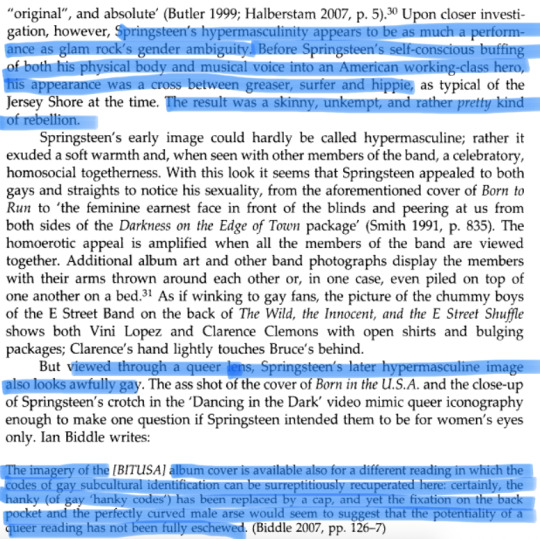
Springsteen’s hypermasculinity appears to be as much a performance as glam rock’s gender ambiguity. Before Springsteen’s self-conscious buffing of both his physical body and musical voice into an American working-class hero, his appearance was a cross between greaser, surfer and hippie... The result was a skinny, unkempt, and rather pretty kind of rebellion.
...viewed through a queer lens, Springsteen’s later hypermasculine image also looks awfully gay.
The imagery of the...album cover is available also for a different reading in which the codes of gay subcultural identification can be surreptitiously recuperated here: certainly, the hanky (of gay ‘hanky codes’) has been replaced by a cap, and yet the fixation on the back pocket and the perfectly curved male arse would seem to suggest that the potentiality of a queer reading has not been fully eschewed.

Springsteen precludes definitive determination of sexual preference, mooting a fundamental constraint whereby our culture knows us and names us. Such mooting matters not just because inquiring minds want to know, but because undermining this constraint calls into question conventional representations of love and traditional musical constructions of desire.
Bruce Springsteen’s sexual and gender ambiguity is not only a challenge, it is an invitation... ‘The best records (the ones that give us the most pleasure) are the ones that allow an ambiguity of response, letting us be both the subject and object of the singers’ needs (regardless of their or our gender).’
For Springsteen’s LGBT audience...his queer music is pure pleasure. While one may hope for the day that Springsteen will play ‘My Lover Man’ onstage, the songs with liminal romantic desires no less indicate that our musical hero is a sexual ‘tramp like us.’ As Nadine Hubbs writes, ‘Ambiguity is not particularly confusing to queer subjects to whom its utility and indeed necessity are intimately known.’
#quotations#rosalie zdzienicka fanshel#bruce springsteen#music criticism#queerness#queer themes#queer masculinities#gender#homoeroticism#clarence clemons#steven van zandt#walt whitman#i am obsessed with this article#obsessed with it#i was having backstreets feelings#and did a weird web search#and stumbled upon this#these are some of my favorite excerpts#but honestly just go read the whole thing#it’s SO GOOD
166 notes
·
View notes
Text




‘All them golden-heeled fairies’: homosexuals & gender misfits in Springsteen’s early music
— Rosalie Zdzienicka Fanshel, Beyond Blood Brothers: Queer Bruce Springsteen
248 notes
·
View notes
Text

from Beyond blood brothers: queer Bruce Springsteen by Rosalie Zdzienicka Fanshel
#thinking about her (the essay about queerness in springsteen's music)#also can't stop associating this quote to THEE virgin mary#bruce springsteen#queer#other people's writing#head in hands but like academically
14 notes
·
View notes
Photo

okay but springsteennatural when?
(quote from Rosalie Zdzienicka Fanshel’s Beyond Blood Brothers: queer Bruce Springsteen)
1 note
·
View note
Note
https://at.tumblr.com/1975springsteen/hes-a-switch/u8f598oibpe9 hiii what’s this from
Heyyy it’s from Beyond blood brothers: Queer Bruce Springsteen. Popular Music, 32(3), 359–383 by Rosalie Zdzienicka Fanshel. Here’s a link to her website the pdf to the article is under “Peer-Reviewed Publications” after her bio.
12 notes
·
View notes
Text

from Beyond blood brothers: queer Bruce Springsteen by Rosalie Zdzienicka Fanshel
#OBSESSED with this paragraph#in general this essay is one of the best things i've read in a while#but damn did she leave some casualties in this section#bruce springsteen#queer#other people's writing#head in hands but like academically
3 notes
·
View notes

